Strategic bomber
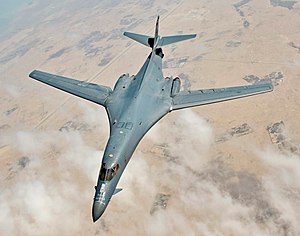
Astrategic bomberis a medium- to long-rangepenetrationbomberaircraft designed to drop large amounts ofair-to-ground weaponryonto a distant target for the purposes of debilitating the enemy's capacity to wage war. Unliketactical bombers,penetrators,fighter-bombers,andattack aircraft,which are used inair interdictionoperations to attack enemy combatants and military equipment, strategic bombers are designed to fly into enemy territory to destroy strategic targets (e.g.,infrastructure,logistics,military installations,factories, etc.). In addition tostrategic bombing,strategic bombers can be used fortactical missions.There are currently only three countries that operate strategic bombers: theUnited States,Russia[1]andChina.
The modern strategic bomber role appeared afterstrategic bombing was widely employed,andatomic bombs were first used in combatduringWorld War II.Nuclear strike missions (i.e., deliveringnuclear-armedmissilesorbombs) can potentially be carried out by most modernfighter-bombersandstrike fighters,even at intercontinental range, with the use ofaerial refueling,so any nation possessing this combination of equipment and techniques theoretically has such capability. Primary delivery aircraft for a modern strategic bombing mission need not always necessarily be aheavy bombertype, and any modern aircraft capable of nuclear strikes at long range is equally able to carry outtactical missionswithconventional weapons.An example isFrance'sMirage IV,a small strategic bomber replaced in service by theASMP-equippedMirage 2000Nfighter-bomberandRafalemultirole fighter.
History[edit]
First and Second World Wars[edit]
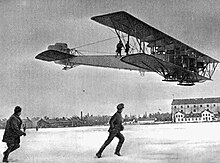
Thefirst strategic bombing effortstook place duringWorld War I(1914–18), by theRussianswith theirSikorsky Ilya Murometsbomber (the first heavy four-engine aircraft), and by theGermansusingZeppelinsor long-range multi-engineGothaaircraft.Zeppelins reachedEnglandon bombing raids by 1916, forcing the British to create extensive defense systems including some of the firstanti-aircraft gunswhich were often used with searchlights to highlight the enemy machines overhead. Late in the war,Americanfliers under the command of Brig. Gen.Billy Mitchellwere developing multi-aircraft "mass" bombing missions behind German lines, although theArmisticeended full realization of what was being planned.
Study of strategic bombing continued in the interwar years. Many books and articles predicted a fearful prospect for any future war, paced by political fears such as those expressed byBritish Prime MinisterStanley Baldwinwho told theHouse of Commonsearly in the 1930s that "the bomber will always get through"no matter what defensive systems were undertaken. It was widely believed by the late 1930s thatstrategic "terror" bombing of citiesin anywarwould quickly result in devastating losses and might decide a conflict in a matter of days or weeks. But theory far exceeded what most air forces could actually put into the air. Germany focused on short-range tactical bombers.Britain'sRoyal Air Forcebegan developing four-engine long-range bombers only in the late 1930s. TheU.S. Army Air Corps(Army Air Forcesas of mid-1941) was severely limited by small budgets in the late 1930s, and only barely saved theB-17bomber that would soon be vital. The equally importantB-24first flew in 1939. Both aircraft would constitute the bulk of the bomber force forUSAAF strategic bombing in EuropeandAlliedday bomberunits more generally.
At the start ofWorld War II,so-called "strategic" bombing was initially carried out bymedium bomberaircraftwhich were typically twin-engined, armed with several defensive guns, but only possessed limitedbomb-carrying capacity andrange.BothBritainand theUSwere developing larger two- and four-engined designs, which began to replace or supplement the smaller aircraft by 1941–42. After American entry into the war in December 1941, the U.S.8th Air Forcebegan to develop adaylight bombing capacityusing improvedB-17andB-24four-engine aircraft. In order to assemble the formations to carry out these bombing campaigns,assembly shipswere used to quickly form defensivecombat boxes.TheRAFconcentrated its efforts on night bombing.But neither force was able to develop adequatebombsightsor tactics to allow for often-bragged "pinpoint" accuracy. The post-war U.S.Strategic Bombing Surveystudies supported the overall notion of strategic bombing, but underlined many of its shortcomings as well. Attempts to create pioneering examples of "smart bombs"resulted in theAzonordnance, deployed in theEuropean TheaterandCBI Theaterfrom B-24s.

Following the untimely death of the top German advocate for strategic bombing,GeneralWalther Weverin early June 1936, the focus of Nazi Germany'sLuftwaffebomber forces, the so-namedKampfgeschwader(bomber wings) became the battlefield support of theGerman Armyas part of the generalBlitzkriegform of warfare, carried out with both medium bombers such as theHeinkel He 111,andSchnellbomberssuch as theJunkers Ju 88A. Support for theUral bomberproject before the start of WW II dwindled after Wever's death, with the only aircraft design that could closely match the Allied bomber force's aircraft – theHeinkel He 177A, originated in early November 1937, deployed in its initial form in 1941–42, hampered by aRLMrequirement for it to also perform medium-angledive bombing,not rescinded until September 1942 – unable to perform either function properly, with a powerplant selection and particular powerplant installation design features on the 30-meter wingspanGreif,that led to endless problems with engine fires. The trans-Atlantic rangedAmerika Bomberprogram started in March 1942 sought to ameliorate the lack of a long-range bomber for theLuftwaffe,but led only to threeMesserschmitt- and twoJunkers-built prototypes ever flying, and no operational "heavy bombers" for strategic use for the Third Reich beyond the roughly one thousand He 177s built.
By the end of the Second World War in 1945, the "heavy" bomber, epitomized by the BritishAvro Lancasterand AmericanBoeing B-29 Superfortressused in thePacific Theater,showed what could be accomplished byarea bombingof Japan's cities and the often small and dispersed factories within them. Under Major GeneralCurtis LeMay,the U.S.20th Air Force,based in theMariana Islands,undertook low-levelincendiary bombingmissions, results of which were soon measured in the number of square miles destroyed. Theair raids on Japanhad withered the nation's ability to continue fighting, although the Japanese government delayed surrender untilatomic bombs were droppedonHiroshimaandNagasakiin August 1945.
The Cold War and its aftermath[edit]
During theCold War,the United States and United Kingdom on one side and theSoviet Unionon the other kept strategic bombers ready totake offon short notice as part of thedeterrentstrategy ofmutually assured destruction(MAD). Most strategic bombers of the twosuperpowerswere designed to delivernuclear weapons.For a time, some squadrons ofBoeing B-52 Stratofortressbombers were kept in the air around the clock,orbitingsome distance away from theirfail-safepoints near the Soviet border.
The British produced three different "V bombers"for theRoyal Air Forcewhich were designed and designated to be able to deliver British-made nuclear bombs to targets in European Russia. These bombers would have been able to reach and destroy cities such as Kiev or Moscow before American strategic bombers. While they were never used against the Soviet Union or its allies, two V bomber types, theAvro Vulcanand theHandley Page Victor,were used in theFalklands Wartowards the end of their operational lives.
The Soviet Union produced hundreds of unlicensed copies of the AmericanBoeing B-29 Superfortress,which theSoviet Air Forcescalled theTupolev Tu-4.The Soviets later developed thejet-poweredTupolev Tu-16"Badger".
The People's Republic of China produced a version ofTupolev Tu-16on license from the Soviet Union in the 1960s, which they named theXian H-6.
During the 1960s France produced itsDassault Mirage IVnuclear-armed bomber for theFrench Air Forceas a part of its independent nuclear strike force, theForce de Frappe,using French-made bombers andIRBMsto deliver French-madenuclear weapons.Mirage IVs served until mid-1996 in the bomber role, and to 2005 asreconnaissance aircraft.
The French Republic limited its strategic armaments to a squadron of fournuclear-poweredballistic missile submarines,with 16SLBMtubes apiece. France also maintains an active force of supersonicfighter-bomberscarryingASMPstand-off nuclearmissiles,withMach3 speed and a range of 500 kilometers. These missiles can be delivered by theDassault Mirage 2000NandRafalefighter-bombers;the Rafale is also capable ofrefuelingothers in flight using abuddy refueling pod.

Newer strategic bombers such as theRockwell B-1 Lancer,theTupolev Tu-160,and theNorthrop Grumman B-2 Spiritdesigns incorporate various levels ofstealth technologyin an effort to avoid detection, especially byradarnetworks. Despite these advances earlier strategic bombers, for example theB-52last manufactured in 1962 and theTupolev Tu-95,remain in service and can also deploy the latest air-launchedcruise missilesand other "stand-off"orprecision guided weaponssuch as theJASSMand theJDAM.
TheRussian Air Force's newTu-160M2strategic bombers are expected to be delivered on a regular basis over the course of 10 to 20 years[when?].TheTu-95and Tu-160 bombers will be periodically updated, as was done during the 1990s with theTu-22Mbombers.
Strategic bombers of theCold Warwere primarily armed with nuclear weapons. During the post-1940sIndochina Wars,and also since the end of the Cold War, modern bombers originally intended forstrategicuse have been exclusively employed usingnon-nuclear,high explosiveweapons. During theVietnam War,Operation Menu,Operation Freedom Deal,Gulf War,military action in Afghanistan,and the2003 invasion of Iraq,American B-52s and B-1s were mostly employed intacticalroles. During theSoviet-Afghan warin 1979–88,Soviet Air ForcesTu-22Ms carried out severalmass air raidsin various regions ofAfghanistan.
Notable strategic bombers[edit]
Nomenclature[edit]
Bombers listed below were used in the main or represented a shift in long-range bomber design (Maximum bomb load). In practice, bomb loads carried are dependent on factors such as the distance to target and the individual type, size or weight of bombs used.
Nomenclature for size classification of aircraft types used instrategic bombingvaries, particularly since the time of World War II due to sequential technological advancements and changes inaerial warfarestrategy and tactics. TheB-29,for example was a benchmark aircraft of theheavy bombertype at end ofWorld War IIdue to its size, range and load carrying ability; as theCold Warbegan, it became an intercontinentalrangestrategic bomber with the development of new techniques, such asaerial refueling(which also greatly extended the range of other medium- to long-rangebombers,fighter-bombersandattack aircraft).
During the 1950s the U.S.Strategic Air Commandalso briefly brought back the outdated term "medium bomber"to distinguish itsBoeing B-47 Stratojetsfrom somewhat larger contemporaryBoeing B-52 Stratofortress"heavy bombers"in bombardment wings; olderB-29andB-50heavy bomberswere also redesignated as "medium" during this period.[2][3][4]SAC'snomenclaturehere was purely semantic and bureaucratic, however as both the B-47 and B-52 strategic bombers were much larger and had far greater performance and load-carrying ability than any of the World War II-era heavy or medium bombers.
Other aircraft such as the twin-jetUSFB-111,Douglas A-3 SkywarriorandFrance'sDassault Mirage IVhad nominal warloads of less than 20,000 lb (9,100 kg), and were significantly smaller in size and gross weight compared with their strategic bomber contemporaries, based on which they might be classified asmedium bombers.In thenuclearstrike role, France would replace its Mirage IVs beginning in the late 1980s with the even smaller, single-engineMirage 2000Nfighter-bomber,a further example of advancing technologies and changing tactics inmilitary aviationandaircraft design.France's newer twin-engineDassault Rafalemultirole fighteralso hasnuclearstrike capability.
World War I[edit]
- Caproni Ca.1
- Caproni Ca.3(1,700 lb (770 kg))
- Gotha G.IV(1,100 lb (500 kg))
- Zeppelin Staaken R.VI(4,400 lb (2,000 kg))
- Zeppelin(about 5,000 lb (2,300 kg))
- Handley Page Type O(2,000 lb (910 kg))
- Handley Page V/1500(7,500 lb (3,400 kg))
- Sikorsky Ilya Muromets(1,100 lb (500 kg))
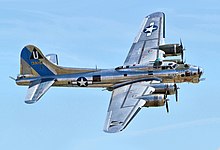
Interwar/World War II[edit]
- Boeing YB-9(prototype strategic bomber, inspiration for the B-17)
- Martin B-10(successors B-17 and B-24 therefore and theoretically the first strategic bomber of the USAAF at that time despite being a medium bomber.)
- Boeing B-17 Flying Fortress(8,000 lb (3,600 kg)) (theoretical maximum: 17,410 lb (7,900 kg))
- Consolidated B-24 Liberator(8,000 lb (3,600 kg))
- Boeing B-29 Superfortress(20,000 lb (9,100 kg)) (maximum of 44,000 lb (20,000 kg) (2 22,000 lb (10,000 kg) Grand Slams))
- Consolidated B-32 Dominator(20,000 lb (9,100 kg))
- Handley Page Halifax(13,000 lb (5,900 kg))[5]
- Avro Lancaster(22,000 lb (10,000 kg))
- Short Stirling(18,000 lb (8,200 kg))
- Farman F.220(9,240 lb (4,190 kg))
- Heinkel He 177(15,870 lb (7,200 kg))
- Petlyakov Pe-8(11,000 lb (5,000 kg))
- Piaggio P.108(7,700 lb (3,500 kg))
Cold War[edit]
Weapons loads can includenuclear-armedmissilesas well asaerial bombs
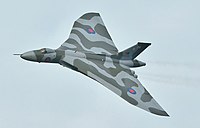
- Reciprocating/Turbineengine
- North American AJ Savage(12,000 lb (5,400 kg))
- Lockheed P-2 Neptune– small number converted ascarrier-launched nuclear-armed bombers which would have to ditch/recover at land bases
- Boeing B-50 Superfortress(28,000 lb (13,000 kg))
- Convair B-36 Peacemaker(72,000 lb (33,000 kg))
- Tupolev Tu-4–reverse-engineeredversion of B-29 Superfortress
- Tupolev Tu-95(55,000 lb (25,000 kg))
- Avro Lincoln(22,000 lb (10,000 kg))
- Jet engine
- North American B-45 Tornado(22,000 lb (10,000 kg))
- Boeing B-47 Stratojet(25,000 lb (11,000 kg))
- Douglas A-3 Skywarrior– nuclear-armed,carrier-based
- Boeing B-52 Stratofortress(70,000 lb (32,000 kg))
- Myasishchev M-4(52,910 lb (24,000 kg))
- Tupolev Tu-16(20,000 lb (9,100 kg))
- Vickers Valiant(21,000 lb (9,500 kg))
- Avro Vulcan(21,000 lb (9,500 kg))
- Sud Aviation Vautour
- Handley Page Victor(35,000 lb (16,000 kg))
- Xian H-6(26,400 lb (12,000 kg))
- Supersonic
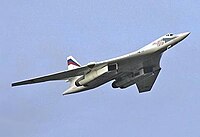
Russian Air ForceTupolev Tu-160 - Convair B-58 Hustler(19,450 lb (8,820 kg))
- General Dynamics FB-111A– strategic bomber version of theF-111swing wingstrike aircraft
- North American A-5 Vigilante– nuclear-armed,carrier-based (only deployed for a brief period in strategic nuclear strike role for which it was originally designed before transitioning to reconnaissance role)
- Rockwell B-1 Lancer(75,000 lb (34,000 kg) – use of external hardpoints restricted bySTART I)
- Dassault Mirage IV(16,000 lb (7,300 kg))
- Tupolev Tu-22MBackfire (46,300 lb (21,000 kg))
- Tupolev Tu-160Blackjack (88,200 lb (40,000 kg))
- Tupolev Tu-22Blinder (20,000 lb (9,100 kg))
- others designed and built which did not enter operational service:
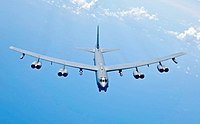
Post Cold War[edit]
- Boeing B-52 Stratofortress(70,000 lb (32,000 kg))
- Northrop Grumman B-2 Spirit(40,000 lb (18,000 kg))
- Rockwell B-1 Lancer(75,000 lb (34,000 kg))
- Tupolev Tu-22M(46,300 lb (21,000 kg))
- Tupolev Tu-95(55,000 lb (25,000 kg))
- Tupolev Tu-160(88,200 lb (40,000 kg))
- Xian H-6(26,400 lb (12,000 kg))
Future[edit]
- Xian H-20.An under-development stealth bomber by China. Planned to be deployed in 2025.
- Northrop Grumman B-21 Raider.An under-development stealth bomber by the United States, with a goal of supplanting the current Rockwell B-1 Lancer and Northrop Grumman B-2 Spirit.
- Tupolev PAK DA.An under-development stealth bomber by Russia, with a goal of supplanting a portion or all of the current Tupolev Tu-95. Planned to be deployed in 2027.
See also[edit]
References[edit]
- ^Paul, T. V.; Wirtz, James J.; Fortmann, Michael.Balance of power: theory and practice in the 21st century,Stanford University Press, 2004, p. 332.ISBN0-8047-5017-3
- ^"Factsheets: Boeing RB-47H Stratojet".12 November 2014. Archived from the original on 12 November 2014.Retrieved31 March2018.
{{cite web}}:CS1 maint: bot: original URL status unknown (link) - ^"Eighth Air Force History: U.S. Air Force Fact Sheet".af.mil.Archived fromthe originalon 21 February 2013.Retrieved31 March2018.
- ^Strategic-Air-Command,509th Composite Group, 509th Bombardment Wing
- ^for the Mark III
- Brown, Michael E. Flying Blind: The Politics of the U.S. Strategic Bomber Program. Ithaca, NY: Cornell University Press, 1992.
- Cross, Robin. The Bombers: The Illustrated Story of Offensive Strategy and Tactics in the Twentieth Century. New York: Macmillan, 1987.
- Green, William. Famous Bombers of the Second World War. New York: Doubleday, 1959, 1960 (two vols).
- Green, William. Warplanes of the Third Reich. New York: Doubleday, 1970.
- Haddow, G. W., and Peter M. Grosz The German Giants: The German R-Planes 1914–1918. London: Putnam, 1969 (2nd ed.)
- Hastings, Max. Bomber Command. New York: Dial Press, 1979
- Jones, Lloyd S. U.S. Bombers 1926 to 1980s. Fallbrook, CA: Aero Publishers, 1980 (3rd ed.)
- Neillands, Robin. The Bomber War: The Allied Offensive Against Nazi Germany. Woodstock, NY: Overlook, 2001.
- Robinson, Douglas H. The Zeppelin in Combat: A History of the German Naval Airship Division, 1912–1918. Atglen, PA: Schiffer, 1994.
- United States Strategic Bombing Survey. Over-all Report (European War). Washington: Government Printing Office, September 30, 1945.
